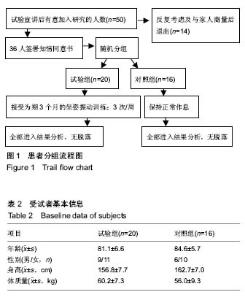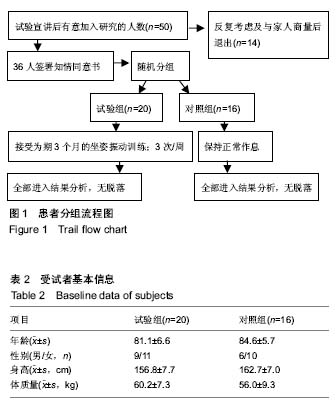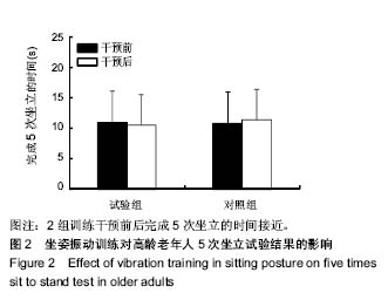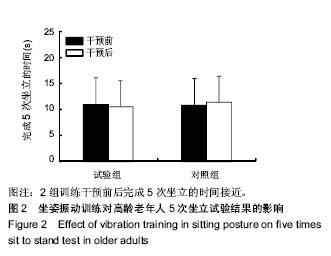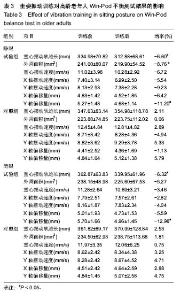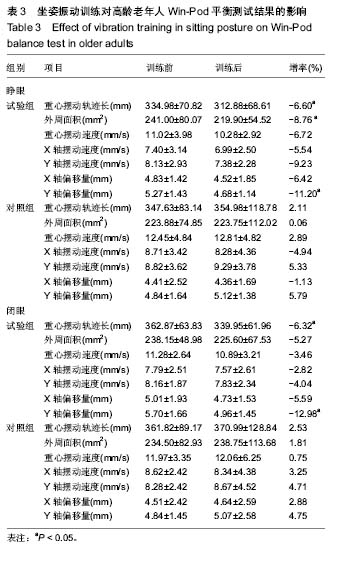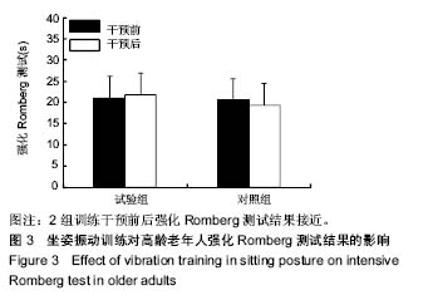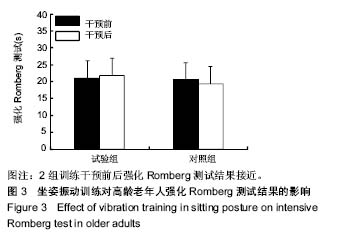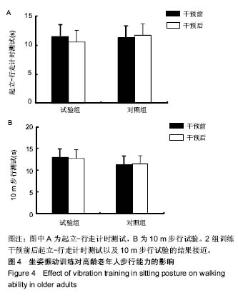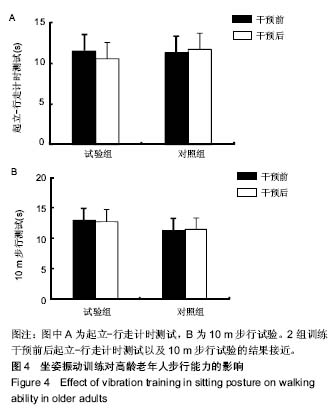| [1] 孙建萍,周雪,杨支兰,等.我国养老机构现状及对策[J].中国老年学杂志,2011,31(23):4723-4724.[2] 黄乾.中国老年人口的就业新态势与战略对策[J].探索与争鸣, 2015, (12):32-34.[3] 乔晓春,陈卫.中国人口老龄化:世纪末的回顾与展望[J].人口研究,1999(6):28-37.[4] 黄海波.传统与新兴养老模式的互补与对接[J].人民论坛,2017(6): 76-77.[5] 谢代银.新形势下发展社会化养老模式研究[J].探索,2008, (2): 116-118.[6] 彭春政,危小焰.振动刺激与肌肉力量[J].中国运动医学杂志,2004, 23(6):708-710.[7] 危小焰,彭春政.振动力量训练对肌肉力量的影响研究[J].体育科研,2004,25(4):53-56.[8] 卜淑敏,韩天雨.全身振动训练在运动训练和康复领域中的应用及研究进展[J].北京体育大学学报,2014,37(8):65-70.[9] 王兴泽.振动负荷训练研究进展[J].中国运动医学杂志,2012,31(7): 648-653.[10] 张丽,瓮长水.全身振动训练治疗骨质疏松症的临床和基础研究进展[J].中国康复理论与实践,2014,20(10):935-939.[11] 张帆,王长生,袁艳,等.不同屈膝角度与g值全身振动刺激对下肢肌肉影响的研究[J].北京体育大学学报,2014,37(11):86-91.[12] 李玉章.不同振动模式中小腿肌肉的诱发激活特征比较研究[J].天津体育学院学报,2010,25(4):336-339.[13] 瓮长水,王娜,刘立明,等.5次坐立试验用于预测老年人跌倒危险的有效性[J].中国康复医学杂志,2012,27(10):908-912.[14] 王军,徐新智,刘亚平,等.动态足底压应力测试分析及骨科临床应用[J].医用生物力学,1997(3):170-174.[15] 梁小娟.长期不同运动对老年人静态平衡能力的影响研究[D].上海:上海体育学院,2016.[16] 燕铁斌."起立-行走"计时测试简介--功能性步行能力快速定量评定法[J].中国康复理论与实践,2000,6(3):115-117.[17] 李青青,吴宗耀.正常步态10m自由步行胫前后肌群的SEMG研究[J].中国康复,2006,21(4):239-241.[18] 肖春梅,李阳,党繁义.老年人跌倒与平衡能力下降的相关测试指标[J].中国康复医学杂志,2003,18(8):457-459.[19] 张少伟,邹晓峰,张浩.全身振动训练对老年人下肢肌力影响的实验研究[J].沈阳体育学院学报,2013,32(4):79-81.[20] 张丽,瓮长水,赵占波.全身振动训练对老年人下肢肌肉力量及功能干预效果的Meta分析[J].中国康复理论与实践,2015,21(10): 1222-1228.[21] 谭景旺.全身振动训练对老年人下肢功能和慢性疾病影响的研究与进展[J].中国组织工程研究,2017,21(8):1288-1293.[22] 刘卉,凤翔云.不同频率振动训练对下肢爆发力和柔韧性的即时影响研究[J].体育科学,2010,30(12):71-75.[23] 袁艳,苏彦炬,吴贻刚.负重振动训练对下肢快速力量的影响及其神经适应的特征[J].北京体育大学学报,2016,39(11):62-67.[24] Hagbarth KE, Eklund G. Tonic vibration reflexes (TVR) in spasticity. Brain Res. 1966;2(2):201-203.[25] 刘北湘,龙小安,李昭洁.振动训练作用目标主要是肌肉中弹性成分的实验研究[J].成都体育学院学报,2014,40(6):46-50.[26] 冯元桢.生物力学[M].北京:科学出版社,1983:145-156.[27] 罗蔚茵.力学简明教程[M].广州:中山大学出版社,1987.[28] 曹宪棣,刘振田.人体频响函数的测量和分析[J].东南大学学报(自然科学版),1986,16(2):20-28.[29] 刘北湘.振动波方向、频率对振动训练的影响[J].武汉体育学院学报,2011,45(6):83-87.[30] 刘北湘.振动训练对肌肉弹性成分的影响[J].成都体育学院学报, 2011,37(9):55-59.[31] 黄小兵,刘博.平衡三联及中枢整合在人体平衡中的作用[J].听力学及言语疾病杂志,2009,17(6):534-536.[32] 邹晓峰,张云开.全身振动训练对老年人姿势控制能力影响的实验研究[J].广州体育学院学报,2015,35(4):77-79.[33] Cardinale M, Bosco C. The use of vibration as an exercise intervention. Exerc Sport Sci Rev. 2003;31(1):3-7.[34] 徐本华,李雪迎,谢斌,等.正常人静态姿势图参数参考值研究[J].中华物理医学与康复杂志,2004,26(7):411-414.[35] 林长地,程亮,林晞.全身振动训练对老年女性平衡能力和下肢关节肌力的影响[J]. 首都体育学院学报,2015,27(6):572-576.[36] 姚波,金建明,霍文璟,等.老年人下肢伸膝肌力对平衡功能的影响[J].中华物理医学与康复杂志,2006,28(7):466-468.[37] Shumway-Cook A, Woollacott MH. 运动控制原理与实践[M].北京:人民卫生出版社,2009.[38] 黄超,瓮长水,马延爱,等.计时“起立-行走”测试在评价脑卒中患者日常生活活动能力中的价值[J].中国康复,2006,21(2):83-84.[39] 朱娟,钮金圆,张文通.计时起立行走和最大步行速度评估脑卒中患者功能的对比分析[J].中国康复医学杂志, 2017,32(9): 1026-1029. |
